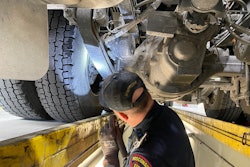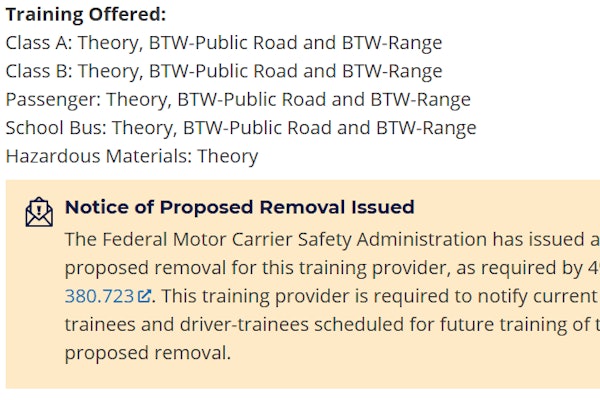Raman Dhillon, CEO of the North American Punjabi Trucking Association (NAPTA), came face to face with former President Joe Biden during the rollout of the Biden-Harris Trucking Action Plan and warned his administration of a coming "crisis."
The Biden-Harris Trucking Action Plan doesn't outright invoke the "driver shortage" narrative preferred by big fleets and detested by much of small biz trucking, but from its first bullet point the plan makes clear an aim to ease access to CDLs and drivers.
The plan, released originally in December of 2021, as the nation crept out of the pandemic and rates were high and capacity tight, articulates as its first goal to "take steps to reduce barriers to drivers getting CDLs," according to the plan. "FMCSA will provide over $30 million in funding to help states expedite CDLs. Today, FMCSA is sending all 50 states a toolkit detailing specific actions they can take to expedite licensing and will work hand-in-hand with states to address challenges they are facing."
Fast-forward to 2025 as the trucking industry enters its third year of loose capacity, sunken rates, and even "driver shortage" boosters like the American Trucking Associations backing off the notion that the country needs more truck drivers. On top of that, a groundswell of truckers report a big uptick of drivers who can't speak English, various unsafe practices and fraudulent operations double brokering freight.

It's exactly what Dhillon warned the White House about, he said.
[Related: New research takes aim at 'driver shortage' narrative, tracing roots to 1980s deregulation]
Fast track to influence beyond the margins
Raman Dhillon started driving trucks in 1996 locally before going long-haul briefly, then starting a fleet that quickly grew to more than 100 trucks. He knows firsthand what drivers go through on the road. He's since handed off operations of the fleet and started up two bilingual publications for truckers -- the Punjabi Trucking Magazine and the Latino Trucking Magazine.
He's also the CEO of NAPTA, a trade association started in 2018 that's now grown to about 2,500 members.
"Basically right now we do work with members simply bulk buying lots of different products like fuel and tires and passing the savings to the members," said Dhillon. "We work with DOT and FMCSA directly," bringing the "education or the knowledge we gain from that department directly to the members." Dhillon's role leading NAPTA landed attention from the Biden White House.
"It was in 2021 when the department -- actually it was Meera Joshi leading FMCSA at the time -- she reached out and we got involved heavily with FMCSA and then DOT," he said. "We were one of only three minority associations, including She Trucking and Real Women in Trucking," working with the Biden administration on the trucking plan. The Biden-Harris Trucking Action Plan placed special emphasis on bringing women and other "underrepresented" groups into the trucking workforce.
 North American Punjabi Trucking Association CEO Raman Dhillon meets with President Joe Biden during the rollout of the Biden-Harris Trucking Action Plan. Courtesy of Raman Dhillon
North American Punjabi Trucking Association CEO Raman Dhillon meets with President Joe Biden during the rollout of the Biden-Harris Trucking Action Plan. Courtesy of Raman Dhillon
"We, the three minority associations, raised a question and challenged the driver shortage" narrative, he said. "There's no driver shortage. It's just made up. We have the problem that the big trucking companies are not taking care of their driver, and drivers leave the industry within the first year of their joining." Dhillon referenced big fleets with their own training programs, which might bring "100 people in, get funding for their schools and all kinds of things to do that, and out of those 100 people, within the first year 90 leave."
[Related: Has Biden's FMCSA sacrificed a measure of government goodwill on the speed-limiter altar]
As Dhillon told the story, he and the other smaller associations "said in front of DOT and FMCSA and DOL and OSHA that this is going to be a crisis coming in. ... A person crossing the border with no experience or nothing gets a work permit in two months, and within one month gets their CDL. Well, they never even drove a car in this country, so why are we doing this?" he recalled telling Biden administration officials. "This is not even an issue for the trucking industry. This is a national security issue."
That warning fell on deaf ears, he said. At the White House, surrounded by all manner of trucking interests, from big and small business to all manner of associations, their message didn't get across, he said. "Seriously, I’m saying there was no attention paid to it. I repeatedly met with FMCSA administrators" to point out that states are handing "licenses out left and right. States are issuing licenses without even taking a test first," he alleged. Training associations themselves recently called out lax enforcement around the FMCSA's training provider registry, saying "unscrupulous" actors are putting dangerous drivers on the road.
[Related: FMCSA really cracking the whip on 'bad actor' CDL schools?]
Dhillon said he repeatedly tried to point out to the Biden administration that, rather than a driver shortage, the "huge and bigger problem is our DMVs, or authorities that issue licenses. How come these people that do not know English pass through the exam? There’s no way."
California, where NAPTA is based, offers CDL testing in English, Arabic, Chinese, Punjabi, Russian and Spanish, but the skills tests take place in English.
"My question is why?" said Dhillon. "Give me a reason why you want to test in Punjabi? Most of the schools in California have opened up schools in Utah because in Utah there’s third-party testing, and you can get unlimited tries," he said, alleging California-based operations will bus drivers over to Utah to get CDLs. Referencing the recent bust of a CDLs-for-cash scheme at a Florida DMV, Dhillon pointed out that sometimes, they don't even take a test, just cash.
According to recent Overdrive polling, 61% of responding truckers estimated that at least 15% of drivers on the road today can't meet the English-proficiency standards in regulation, and 75% doubt foreign citizens can operate safely or fairly on the road. Some survey respondents described a collapse in road safety and equipment maintenance, blaming it on fly-by-night operations that likely abuse foreign workers.
[Related: California cargo thief's 'No Name Given' CDL, explained]
Trucking should clean its house before opening up
Given the priorities of the Biden-Harris plan, the influx of drivers who can't speak English "was bound to happen," Dhillon said. He believes the ability to communicate in English "is a basic requirement of the job. It's not somebody pushing something on somebody. If your family or my family are driving and the truck driver coming behind doesn't know English, and the traffic and sign say slow down and he doesn’t," disaster awaits.
While he's happy with President Donald Trump's emphasis on English-proficiency enforcement and order of the review of non-domiciled CDLs, at once he's a little worried about it. "I don’t want law enforcement or anyone to use this as a discrimination weapon towards people of color," he said. Dhillon also agrees with concerns about labor fairness, referencing examples of Texas-based fleets employing 100% Mexican drivers making low wages -- "purely, simply taking away the jobs from the people who are in this country," he said.
[Related: Booming interest in English classes in the nation's ELP-violation capital]
Should foreign citizens be allowed to drive trucks in the U.S.? Not until the broken CDL credentialing system gets fixed, he said. "I think — first things first -- our system needs to be better for vetting, and our schools need to be following our rules. DMVs need to do a better job. Trucking companies need to do a better job when they hire their driver. We need to weed out those things before we start bringing in people from another country."
Why not a rule requiring people to drive passenger cars in the country for a year or two before getting a CDL? he suggested. Dhillon called on FMCSA to do its job policing the bad schools, saying he'd made detailed reports to authorities but had seen nothing done. One example: Drivers training with 24 foot box trucks when they intend to pull 53 footers, training on the wrong type of transmission, and more shortcuts that lead to unsafe drivers.
"It was crazy when we talked about these things," he said, "when the ATA was at the table with the other big associations. 'Seriously, you guys don’t even see this?'"














